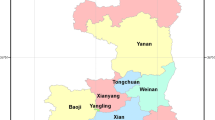Abstract
Water and soil resources are fundamental natural resources. Therefore, it is highly important to understand the resilience of regional water and soil resources, the characteristics of which are nonlinear, self-organized and unpredictable. This study used a projection pursuit model based on the firefly algorithm (FA-PP) to quantitatively evaluate the water and soil system resilience of 15 farms in the Jiansanjiang administration of Heilongjiang Province, China. The results were compared with the results obtained by the projection pursuit model based on the genetic algorithm (GA-PP), and the validity and feasibility of the FA-PP model were verified. Further analysis revealed that the key factor influencing the resilience of agricultural water and soil resources was the irrigated area. The research results revealed the restoring situation of the local water and soil resource system and provided a foundation for the management of agricultural water and soil resources.




Similar content being viewed by others
References
Atkinson G, Dubourg R, Hamilton K, Munasinghe M, Pearce D, Young C (1997) Measuring sustainable development: macroeconomics and the environment. JSTOR 41(5):647
Batabyal AA (1998) On some aspects of ecological resilience and the conservation of species ☆. J Environ Manag 52(4):373–378
Chang SE, Shinozuka M (2004) Measuring improvements in the disaster resilience of communities. Earthq Spectra 20(3):739–755
Deb K, Pratap A, Agarwal S, Meyarivan T (2002) A fast and elitist multiobjective genetic algorithm: NSGA-II. IEEE Trans Evol Comput 6(2):182–197
Eberhart R, Kennedy J (1995)A new optimizer using particle swarm theory. In: International symposium on MICRO machine and human science, pp 39–43
Feng Z, Zheng H, Liu B (2005) Comprehensive evaluation of agricultural water use efficiency based on genetic projection pursuit model[J]. Trans CSAE 21(3):66–70
Friedman JH, Tukey JW (1973) A Projection pursuit algorithm for exploratory data analysis. IEEE Trans Comput c-23(9):881–890
Fu Q, Jin J (2002) Application of projection pursuit classification model based on real-time accelerated genetic algorithm in optimization of rice irrigation schedule. J Hydraul Eng 33(10):39–45
Goldberg DE (1989) Genetic Algorithms in Search, Optimization and Machine learning[M]. Addison-Wesley Longman Press, Boston
Holling CS (2003) Resilience and Stability of Ecological Systems. Annu Rev Ecol Syst 4(4):1–23
Li H, Jia L, Yao Y, Liu T, Ru S (2013) Analysis on dynamic characteristics of groundwater in Sanjiang Branch of Heilongjiang Province. Water Sav Irrig 06:14–17
Liu J, Shi P, Ge Y, Wang J, Lv H (2006) A summary of the research progress of disaster recovery. Adv Earth Sci 21(2):211–218
Liu J, Shi PJ, Yi GE, Wang JA, Feng LH (2006) The review of disaster resilience research. Adv Earth Sci 4(7):112–118
Lv P, Liu D, Zhao F (2011) Fuzzy matter—element evaluation model of water resources carrying capacity of Sanjiang branch based on entropy. Res Soil Water Conserv 18(2):246–250
Ma J, Guo X, Fu Q, Wang K, Ma X (2014) Study on the configuration of complex adaptation system of regional agricultural water and soil resources—taking Sanjiang plain as an example. Res Soil Water Conserv 21(3):256–260
Mccall J (2005) Genetic algorithms for modelling and optimisation. J Comput Appl Math 184(1):205–222
Ni C, Wang S, Cui P (2006) Projection pursuit dynamic clustering model and its application in groundwater classification. Adv Eng Sci 38(6):29–33
Perrings C (1998) Resilience in the dynamics of economy-environment systems. Environ Resour Econ 11(3):503–520
Perrings C, Stern DI (2000) Modelling loss of resilience in agroecosystems: rangelands in Botswana. Environ Resour Econ 16(2):185–210
Roeva O (2012) Optimization of E. coli cultivation model parameters using firefly algorithm. Int J Bioautom 16(1):242–251
Song X, Du L, Li S, Yan Z, Hou G (2003) Research on the concept, influencing factors and evaluation of ecosystem health. J Henan Agric Univ 37(4):375–378
Sun CZ, Dong-Ling HU, Yang L (2011) Recovery capacity of groundwater system in lower Liaohe River Plain. Adv Sci Technol Water Resour 31(5):5–10
Wang B, Zhang Z, Wei Y et al. (2009) Assessment of agricultural basic drought based om projection pursuit[J]. Trans CASE 25(4):157–162
Wang S, Yang Z, Jing D (2004) Projection pursuit method for comprehensive evaluation of groundwater resources carrying capacity in Guanzhong Plain. Resour Sci 26(6):104–110
Yang XS (2009) Firefly algorithms for multimodal optimization. Mathematics 5792:169–178
Yang XS (2013) Multiobjective firefly algorithm for continuous optimization. Eng Comput 29(2):175–184
Yang XS (2008) Nature-inspired metaheuristic algorithms. Luniver Press, Beckington
Yang XS, He X (2013) Firefly algorithm: recent advances and applications. Int J Swarm Intell 1(1):13–20
Yu X, Liu D (2012) Regional groundwater system complexity measure and its influence on model prediction accuracy. China Rural Water Hydropower 8:65–69
Yu C (2007) Quantitative assessment of water resource system resilience. J Hydraul Eng s1:13–17
Zeng B, Li M, Zhang Y et al. (2013) Research on assembly sequence planning based on fire algorithm[J]. J Mech Eng 49(11):177–184
Zhao F, Liu D, Liu M (2012) Analysis on driving forces of land use structure in Jiansanjiang based on information entropy and gray relation. Res Soil Water Conserv 19(3):250–253
Zhong-En XI, Wang SY (2007) On negative Cronbach alpha coefficient and split-half reliability coefficient. J Chongqing Univ Posts Telecommun 8(5):187–196
Zilong G, Sun’An W, Jian Z (2006) A novel immune evolutionary algorithm incorporating chaos optimization. Pattern Recogn Lett 27(1):2–8
Acknowledgements
This study was supported by the National Natural Science Foundation of China (Nos. 51579044, No. 41071053, No. 51479032), National Key R&D Program of China (No. 2017YFC0406002), Science and Technology Program of Water Conservancy of Heilongjiang Province (Nos. 201319, 201501, 201503).
Author information
Authors and Affiliations
Corresponding author
Rights and permissions
About this article
Cite this article
Liu, D., Mu, R., Fu, Q. et al. An Evaluation of the Resilience of the Regional Agricultural Water and Soil Resource System in Heilongjiang Province, China. Agric Res 7, 311–320 (2018). https://doi.org/10.1007/s40003-018-0312-z
Received:
Accepted:
Published:
Issue Date:
DOI: https://doi.org/10.1007/s40003-018-0312-z




